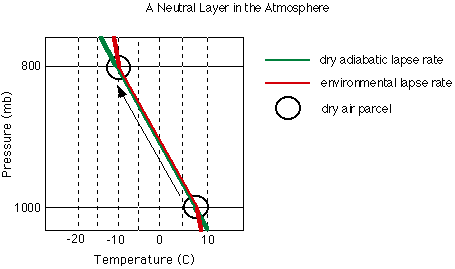
While in a stable atmosphere or layer, the lapse rate of a rising air parcel is greater than the lapse rate of the environment. In a neutral atmosphere, the two lapse rates are equal. If a parcel of air is lifted through a neutral layer, the temperature and pressure of the parcel will be identical to the temperature and pressure of the surrounding air at every height and is always in equilibrium with the environment. Thus, the parcel is not buoyant. If the force producing the motion ceases, the parcel will neither continue to rise nor begin to sink, rather, the motion of a parcel will also cease.
In the diagram above, our dry parcel is lifted, once again, from 1000 mb (100.0 kPa) to 800 mb (80.0 kPa) but in different atmospheric conditions. As the parcel rises and cools according to the dry adiabatic lapse rate, it remains at the same temperature and pressure as the surrounding air. For instance, at 1000 mb (100.0 kPa) the parcel and the environment have a temperature of about 7 degrees Celsius. After the parcel is lifted to 800 mb (80.0 kPa), the temperature of the parcel and the environment is -10 degrees Celsius. At every height in this neutral layer, the parcel is in equilibrium with the environment.
 The Shodor
Education Foundation, Inc.
The Shodor
Education Foundation, Inc.